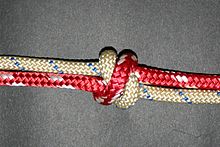True lover's knot
| True lover's knot | |
|---|---|
 This variation is also a form of the Matthew Walker knot (#2421). | |
| Names | True lover's knot, True Love Knot, Fisherman's knot, Middleman's knot,[1] Shamrock knot[1] |
| Category | Bend |
| Related | Fisherman's knot, Matthew Walker's knot |
| Typical use | symbolism, connecting two lines, lanyards, decorative |
| ABoK | #798, #1038, #1143, #1414, #2418, #2301, #2394, #2420, #2421, #2423, #2424, #2425, #2425, #2426 |
The term true lover's knot, also called true love knot is used for many distinct knots. The association of knots with the symbolism of love, friendship and affection dates back to antiquity. Because of this, no single knot can be determined to be the true "true love knot".[2]
In practical terms, these knots are generally shown as consisting of two interlocked overhand knots made in two parallel ropes or cords. The variations are differentiated by the way in which the overhand knots interweave and in the final arrangement of the knot.[3]

The true lovers' knot is a motif in several British folk songs, including "Barbara Allen", "Lord Thomas and Fair Annet", "Lord Lovel", and "Fair Margaret and Sweet William". The knot is made of a rose growing from a man's grave and a brier from a woman's, and is mentioned at the end of the ballad.[4][5] It symbolises their fidelity in love even after death.[6]
Modern western knotting literature has the name for these related knots deriving from stories or legends in which the knots symbolize the connection between a couple in love. Many examples feature sailors separated from their beloved. Ashley notes that it was once common for sailors' wedding rings, where gold wire was wrought to incorporate the "true lovers" knot such that resultant ring would comprise two tori: each flexible to move about the other; yet nevertheless inseparable.[3]
Examples in literature[]
- "A Love Knot"; a short story about Bengali Hindus featuring a goldsmithed love knot.[7]
- A “love-knotte” is also referenced in the prologue to the Canterbury Tales.
- In The Highwayman (poem) by Alfred Noyes, Bess is “plaiting a dark red love-knot into her long black hair.”
See also[]
References[]
- ^ Jump up to: a b Scouting Resources, A-Z of Knots: S-T, retrieved 2009-06-14
- ^ van de Griend, P. (1996), "On the True Love Knot", in Turner, J.C.; van de Griend, P. (eds.), History and Science of Knots, K&E Series on Knots and Everything, 11, Singapore: World Scientific Publishing, pp. 397–417, ISBN 981-02-2469-9
- ^ Jump up to: a b Ashley, Clifford W. (1944), The Ashley Book of Knots, New York: Doubleday, pp. 386–388
- ^ Coffin, Tristram P. (1950). The British Traditional Ballad in North America. Philadelphia: The American Folklore Society. pp. 76–9, 87–90.
- ^ "Versions and Variants of the Tunes of "Barbara Allen"" (PDF).
- ^ Würzbach, Natascha; Simone M. Salz (1995). Motif Index of the Child Corpus: The English and Scottish Popular Ballad. Gayna Walls (trans.). Berlin and New York: Walter de Gruyter. pp. 25, 57. ISBN 3-11-014290-2.
- ^ Theroux, Paul (1997). The Collected Stories. Penguin Group. pp. 164–176.
- Bend knots
- Knot stubs
